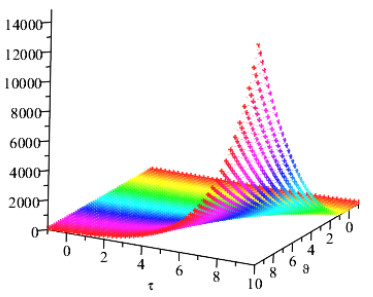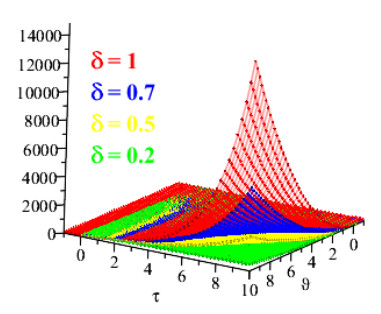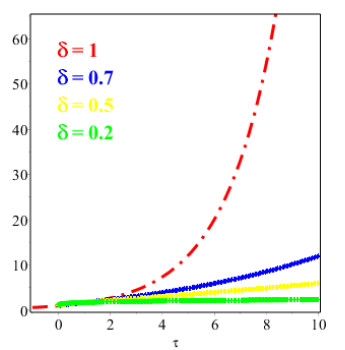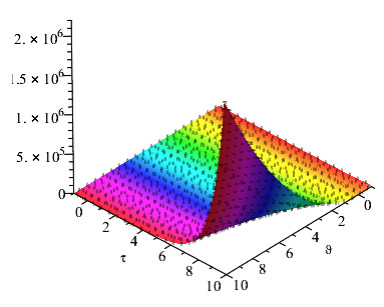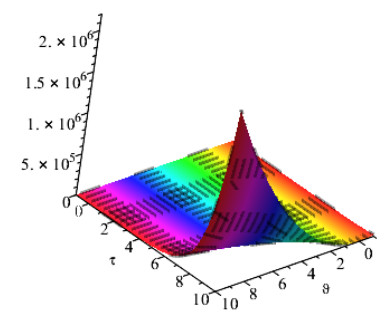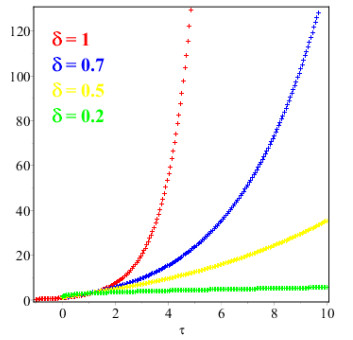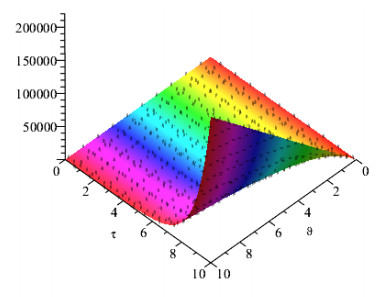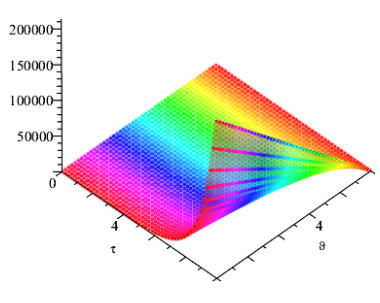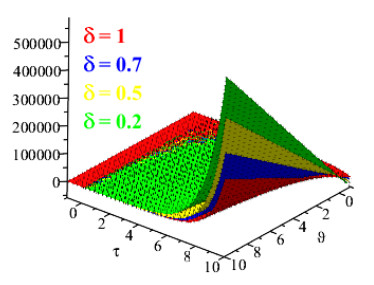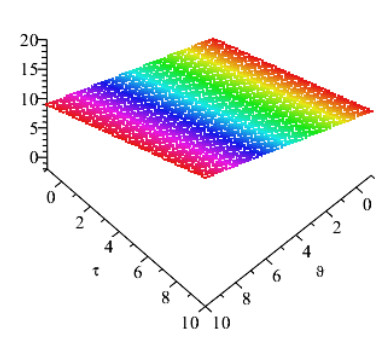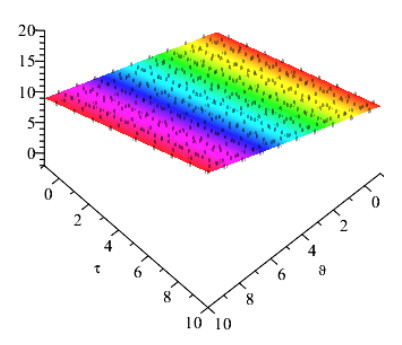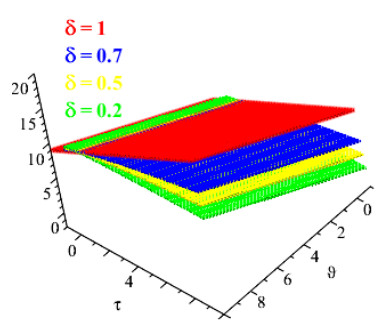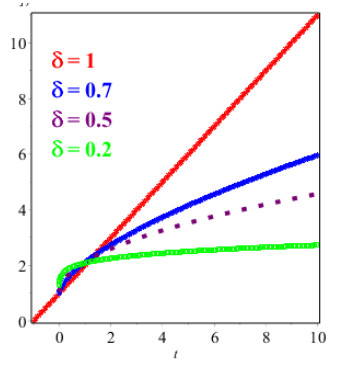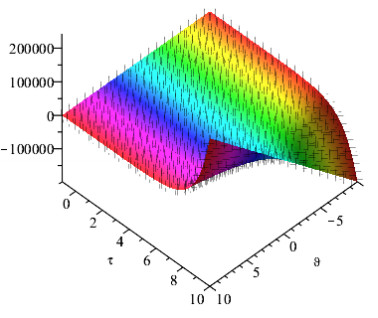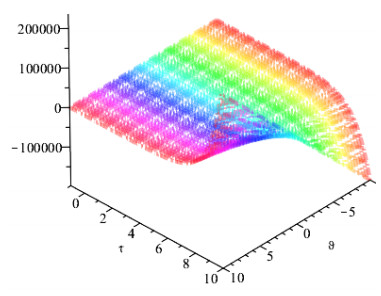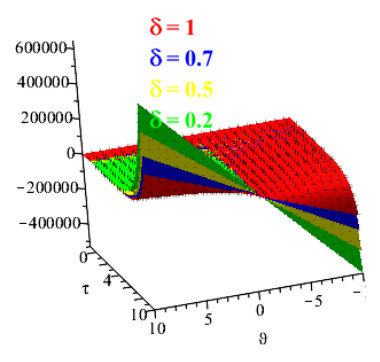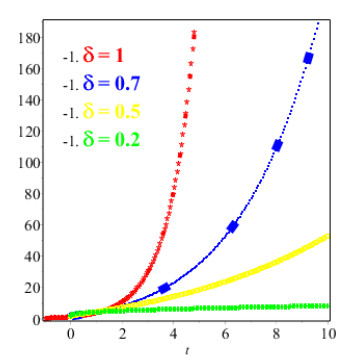1.
Introduction
The ordinary differential equations (ODEs) and partial differential equations (PDEs) are widely used to represent physical phenomena in mathematical language in science and technology. The mathematical form of the physical phenomena easily explains the whole scenario of the phenomena and makes them openly understandable and investigated straightforwardly. Initially, these phenomena were not only modeled accurately by using integer-order differential equations but later on fractional differential equations have over come the deficiencies and comparatively provide the best and adequate modelling of the given problems. Fractional order ODEs and PDEs describe some phenomena more accurately than non-fractional order ODES and PDEs and have numerous applications in applied sciences. It is shown that the fractional-order ODEs and PDEs are non-local and imply that the next state of a system depends on its current state and its previous states. Therefore, the fractional-order derivatives and integration have numerous applications such as the nonlinear oscillation of earth quack is molded with fractional-order derivatives [1], chaos theory [2], fractional diabetes model [3], fractional order Covid-19 Model [4], optics [5], fractional model of cancer chemotherapy [6], effect of fractional order on ferromagnetic fluid [7], the fractional-order fluid dynamic traffic model [2], signal processing phenomena [9], electrodynamics [10], fractional model for the dynamics of Hepatitis B Virus [11], fractional model for tuberculosis [12], fractional-order pine wilt disease model [13], and some others references therein [14,15,16,17,18].
The Korteweg-De Vries (KdV) equation is a mathematical model of waves on shallow water surfaces. It is particularly notable as the prototypical example of an exactly solvable model that is, a non-linear partial differential equation whose solutions can be exactly and precisely specified. KdV can be solved by means of the inverse scattering transform. The mathematical theory behind the KdV equation is a topic of active research. The KdV equation was first introduced by Boussinesq (1877) and rediscovered by Diederik Korteweg and Gustav de Vries (1895) [19].
Among these applications, we have considered Fokker-Planck equations of fractional order of the general from
with initial source
The Fokker-Planck equation (1.1) was introduced by Fokker and Planck to describe the brownian motion of partiles [20]. The Fokker-Plank equation represents the change in probability of a random function in time and space, which explain solute transport. Many phenomena, such as wave propagation, continuous random walk, charge carrier transport in amorphous semiconductors, anomalous diffusion, the motion of ribosomes along mRNA and pattern formation, polymeric networks are modelled by PDEs of both time and space fractional order [21].
Gorge Adomian was the first who proposed Adomian Decomposition Method (ADM) 1980. The crucial aspect of the method is employment of the "Adomian polynomials" which allow for solution convergence of the nonlinear portion of the equation, without simply linearizing the system. ADM is a type of method that uses a decomposition technique to generate approximation and even accurate solutions for non-linear systems with valid initial data. ADM have been used effectively for the solution of partial differential equations (PDE's) and fractional partial differential equations (FPDE's). In recent years, more and more researchers have applied this method to solving non-linear systems [24]. ADM is preferred over other techniques because of its simple implementation for wide range of nonlinear systems, including ordinary and partial differential equations with fractional derivatives. Moreover, ADM can easily handle the solutions of nonlinear fractional problems which is not the case with other techniques. It can be extended easily for higher dimensions problems.
The targeted solutions of fractional order ODEs and PDEs are also the main research focus of the mathematicians. There are many techniques that have been used for the solutions of fractional order Fokker-Planck equations such as Generalized finite differences method (GFDM) [22], radial basis functions finite difference (RBF-FD) [23], adomian decomposition method [25], homotopy perturbation transform method [26], iterative Laplace transform method [27], residual power method [28], finite element method [29], fractional variational iteration method [30], fractional reduced differential transform method [31].
In this article, we have implemented new approximate analytical method (NAAM) for the solution these type Fokker-Planck equations of fractional order. The NAAM is a analytical procedure which provide series form solution. The NAAM technique is easy and straight forward approach. The obtained results are fastly convergent towards the exact solution of each problem. The graphical analysis of NAAM solutions are demonstrated which has good agreement with exact solution of the problems.The remaining paper is systematized as Section 2, shows Preliminary concepts. In Section 3, signifies Procedure of NAAM. Section 4, we explained the implementation of NAAM on Fokker-Planck equations. Section 5, we summarized the obtained results.
2.
Preliminaries and basic concepts
In this section, the related definitions and preliminary concepts of fractional calculus and the procedure of the NAAM are presented.
2.1. Riemann-Liouuille integral operator [32]
The Riemann-Liouuille fractional partial integral denoted by Iδτ, where, δ∈N,δ≥0, which is define as under
where, Γ is represent gamma function.
2.2. Some properties of Riemann-Liouuille fractional partial integral
Let δ,β∈R,∖N, δ,γ>0,ρ>−1, then for the function ψ(ϑ,τ) the operator Iδτ has the following properties.
2.3. Caputo operator of fractional partial derivative [36]
2.4. Theorem [36]
Let ϑ,τ∈R, τ>0, and m−1<ρ<m∈N, then
2.5. Theorem
If there exists a constant 0<γ<1suchthat:
then the sequence of approximate solution converges to the exact solution.
Proof. See [35].
3.
NAAM procedure for the solution of problems[37]
Here, we have analyzed the analytical procedure for the solution of fractional order Fokker-Planck equations by introducing approximate analytical method.
Consider a general form of Fokker-Planck equation as
with initial source
where L,N are linear and non-linear operator respectively.
Before computational procedure, we have defined some mandatory procedural results below.
3.1. Lemma [37]
For Lψ(ϑ,τ)=∑∞0γkLψk(ϑ,τ), the linear term Lψ(ϑ,τ) satisfy the following property
3.2. Theorem [37]
The nonlinear operator Nψ(ϑ,τ), for the parameter λ, we define ψλ(ϑ,τ)=∑∞0λkψk(ϑ,τ), compensate the following property
3.3. Definition [1]
The polynomial χn=χn(ψ0,ψ1,⋯,ψn), can be calculated as
3.4. Definition [31]
For χn=χn(ψ0,ψ1,⋯,ψn), the non-linear term N(ψλ), with using definition (3.4), is represented as
3.5. The existence and uniqueness of NAAM [37]
The following result briefly explain the exitance of NAAM.
Theorem
Let N(ψλ),ψ(ϑ,τ) are define for ϵ−1<δ<ϵ, in (3.1). The Fokker-Planck model (3.1), the unique solution is given as
where, L−δτ(ψ(k−1)) and χ−δ(k−1)τ represent the fractional partial integral of order δ for L(ψk−1) and χ(k−1) with respect to τ.
Proof. The solution of Fokker-Planck equation ψ(ϑ,τ), is obtained by substituting the following expansion
To numerate the Eq (3.1), we can investigate as
along with initial sources
Additionally, the solution of Eq (3.6) is estimated as
using the Caupto-Riemann property on Eq (3.8), we have
assuming Eq (3.9), the initial source, Eq (3.11), become as
By substituting, Eq (3.10), in Eq (3.12), we get
with the help of Theorem (3.4), and Lemma (3.1), the Eq (3.13) become as
the iterative scheme is obtained by comparing the identical power of λ in Eq (3.14), as
4.
NAAM implementation and results discussion [37]
In this section, we have tested the validity and applicability of NAAM by solving some Fokker-Planck equations.
Problem 4.1. Consider a Fokker-Planck equation of time fractional order in the form [36]:
with initial source
for special value δ=1, the exact form solution is
To investigate the solution of the Fokker-Planck equation (21), we compare it with the Eq (6), we get
the genral NAAM solution of Eq (4.1), is assume as
For investigating the approximate solution of Eq (4.2), we process as
where the initial condition is given as
The assume solution of Eq (4.4), is in the form
Using the Caupto-Riemann property on Eq (3.8), we have
assuming the initial condition (3.5), Eq (4.6), become as
by substituting Eq (3.10), in Eq (4.8), we get
the iterative scheme is obtained by comparing the identical power of λ in Eq (4.9), as
Consequently, we get
The NAAM solution is
subsisting Eqs (4.11)–(4.14), in Eq (4.15), we get
Specifically for δ=1, the solution converted to
which converge to exact solution as
Problem 4.2.
Consider a Fokker-Planck equation of time fractional order in the form [36];
with initial source
for special value δ=1, the exact form solution is
To investigate the solution of the Fokker-Planck equation (4.19), we compare it with the Eq (3.1), we get
the general NAAM solution of Eq (4.19), is assume as
For investigating the approximate solution of Eq (4.20), we process as
where the initial condition is given as
The assume solution of Eq (4.23), is in the form
Using the Caupto-Riemann property on Eq (4.23), we have
assuming the initial condition (4.20), Eq (4.26), become as
by substituting Eq (4.25), in Eq (4.27), we get
the iterative scheme is obtained by comparing the identical power of λ in Eq (4.28), as
Consequently, we get
The NAAM solution is
subsisting Eqs (4.30)–(4.33), in Eq (4.34), we get
Specifically for δ=1, the solution converted to
which converge to exact solution as
Problem 4.3.
Consider a Fokker-Planck equation of time fractional order in the form [36];
where initial condition, given as
For special value δ=1, the exact form solution is
To investigate the solution of the Fokker-Planck equation (4.38), we compare it with the Eq (3.1), we get
where, the non-linear term N(ψ(ϑ,τ))=∂2∂ϑ2(ψ2(ϑ,τ))−∂∂ϑ(4ϑψ2(ϑ,τ)).
The general NAAM solution of Eq (4.38), is assume as
For investigating the approximate solution of Eq (4.40), we process as
The assume solution of Eq (4.42), is in the form
Using the Caupto-Riemann property on Eq (4.42), we have
assuming the initial condition 4.39, Eq (4.44), become as
by substituting Eq (4.43), in Eq (4.45), we get
the nonlinear operator N(ψ(ϑ,τ)) is evaluated by using definition (3.4).
The iterative scheme is obtained by comparing the identical power of λ in Eq (4.46), as
Consequently, we get
The NAAM solution is
subsisting Eqs (4.48)–(4.51), in Eq (4.52), we get
Specifically for δ=1, the solution converted to
which converge to exact solution as
Problem 4.4.
Consider a Fokker-Planck equation of time fractional order in the form [36];
with initial source
for special value δ=1, the exact form solution is
To investigate the solution of the Fokker-Planck equation (4.56), we compare it with the Eq (3.1), we get
the general NAAM solution of Eq (4.58), is assume as
For investigating the approximate solution of Eq (4.59), we process as
where initial condition, given as
The assume solution of Eq (4.60), is in the form
Using the Caupto-Riemann property on Eq (4.60), we have
assuming the initial condition (4.57), Eq (4.63), become as
by substituting Eq (4.62), in Eq (4.64), we get
the iterative scheme is obtained by comparing the identical power of λ in Eq (4.65), as
Consequently, we get
The NAAM solution is
subsisting Eqs (4.67)–(4.70), in Eq (4.71), we get
Specifically for δ=1, the solution converted to
which converge to exact solution as
Problem 4.5.
Consider a Fokker-Planck equation of time fractional order in the form [36];
with initial source
for special value δ=1, the exact form solution is
To investigate the solution of the Fokker-Planck equation (4.75), we compare it with the Eq (3.1), we get
the general NAAM solution of Eq (4.75), is assume as
For investigating the approximate solution of Eq (4.77), we process as
where initial condition, given as
The assume solution of Eq (4.79), is in the form
Using the Caupto-Riemann property on Eq (4.79), we have
assuming the initial condition, Eq (4.82), become as
by substituting Eq (4.81), in Eq (4.83), we get
the iterative scheme is obtained by comparing the identical power of λ in Eq (4.84), as
Consequently, we get
The NAAM solution is
subsisting Eqs (4.86)–(4.89), in Eq (4.90), we get
Specifically for δ=1, the solution converted to
which converge to exact solution as
Figures 1 and 2 show the comparison of exact and NAAM solutions while Figures 3 and 4 represent the 2D and 3D solutions graphs respectively of Problem 4.1 at different fractional orders. Figures 5 and 6 show the comparison of exact and NAAM solutions while Figures 7 and 8 represent the 2D and 3D solutions graphs respectively of Problem 4.2 at different fractional orders. Figures 9 and 10 show the comparison of exact and NAAM solutions while Figures 11 and 12 represent the 2D and 3D solutions graphs respectively of Problem 4.3 at different fractional orders. Figures 13 and 14 show the comparison of exact and NAAM solutions while Figures 15 and 16 represent the 2D and 3D solutions graphs respectively of Problem 4.4 at different fractional orders. Figures 17 and 18 show the comparison of exact and NAAM solutions while Figures 19 and 20 represent the 2D and 3D solutions graphs respectively of Problem 4.5 at different fractional orders. Table 1, display the solutions comparison of NAAM with HPM, ADM and exact solutions of Problem 4.2. Table 2, display the solutions comparison of NAAM with HPM, ADM and exact solutions of Problem 4.3. Table 3, display the solutions comparison of NAAM with HPM, ADM and exact solutions of Problem 4.4. Table 4, display the solutions comparison of NAAM with HPM, ADM and exact solutions of Problem 4.5.
5.
Conclusions
In these research notes, we have applied an analytical procedure known as the new approximate analytical method (NAAM). The NAAM provides power series solutions in the form of convergent series with fractional derivatives. It is more powerful than other analytical methods due to its less computational work. It provides the fractional order solution directly using the Caputo-Riemann property. We have tested some Fokker-Planck equations in linear and non-linear cases. The series form solution and graphical representation reflect the applicability and validity. The main advantage of NAAM is that it significantly minimises the numerical computations required to find an analytical solution with fractional order. The fractional order solutions are also found and verified by 3D and 2D representation. Overall, the NAAM provides series form solution with fractional order, which have good agreement with the exact solutions of the problems.
Acknowledgements
Researchers Supporting Project number (RSP-2021/401), King Saud University, Riyadh, Saudi Arabia. This research was funded by National Science, Research and Innovation Fund (NSRF), and King Mongkut's University of Technology North Bangkok with Contract no. KMUTNB-FF-65-24.
Conflict of interest
The authors declare that they have no competing interests.
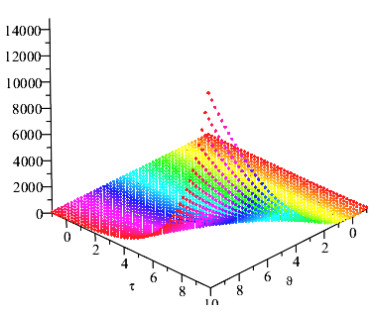









 DownLoad:
DownLoad:
